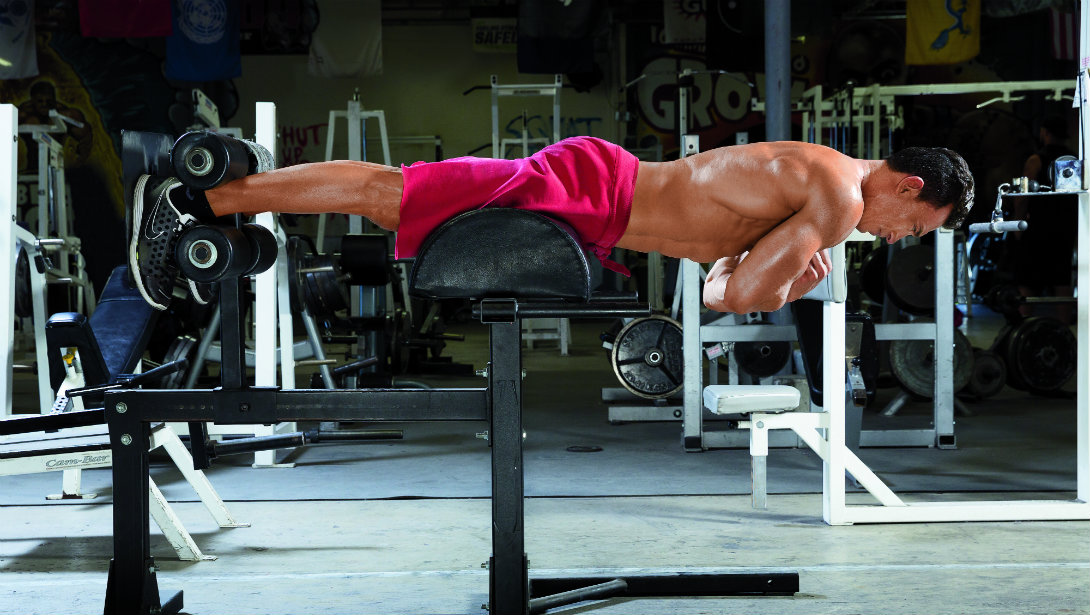Glute Ham Raise Alternatives: How-To & Form Tips

What Makes The Glute Hame Raise Exercise Effective?
The GHR is one of the most effective exercises for the posterior chain because it simultaneously trains your glutes, hamstrings, and spinal erectors. What separates the GHR from other hamstring exercises is that it combines two key movements:
- Knee flexion: Knee flexion to activate the hamstrings in a lengthened position
- Hip extension: Maintaining isometric contraction of the glutes for an extended period.
That combo makes the GHR one of the few exercises that hits both ends of the hamstring—something most curl machines or hip hinge exercises cannot match.
Add to that the eccentric contraction when your hamstrings are lengthening under tension and the isometric glute contraction, and you have an exercise that builds size, strength, and resilience.
What to Look For For A Glue Ham Raise Exercise Alternative
A quality GHR alternative isn’t just any glute or hamstring movement because it must meet a few specific criteria to be included in your program.
Here’s what to look for:
- Direct Glute and Hamstring Engagement: The GHR targets knee flexion and hip extension, so your alternatives should hit the glutes and hamstrings through either or both movements.
- Feel It in All the Right Places: A suitable alternative should create significant tension in the hamstrings, especially during the eccentric phase, which enhances muscle-building potential.
- Spine-Friendly: One of the GHR’s perks is that it delivers glute gains without loading the spine, unlike good mornings or heavy RDLs, which is vital if lower back issues are present.
- Lead to Improved Performance: Whether you aim to enhance your deadlift lockouts or sprint speed or reduce your injury risk, the best alternatives will help you move better and lift heavier.
5 Glute Ham Raise Alternatives To Build Up Your Posterior
Nordic Hamstring Curl
The Nordic hamstring curl overloads the eccentric phase of knee flexion more than any other exercise. You kneel, anchor your heels, and slowly lower your torso toward the floor, using only your hamstrings. The GHR and Nordic train knee flexion, but the Nordic places a heavier eccentric load on the hamstrings, and hip extension strength is less of an issue with the Nordic.
Form Tip: Think plank on the way down.
Sets & Reps: 3-4 sets of 4-6 reps.
Romanian Deadlift
The RDL is a classic exercise that targets the glutes and hamstrings hard and heavy. You hinge your hips back, feel that deep hamstring stretch, then drive your hips forward to lockout. RDLs focus on hip extension with slight knee flexion, but the muscle recruitment and range of motion on the hamstrings make this a viable option.
Form Tip: Fold yourself in half, and keep the weights close to your thighs to maintain tension on the hamstrings.
Sets & Reps: 4 sets of 6-12 reps.
Stability Ball Leg Curl
The stability ball hamstring curl mimics the GHR’s dual action by requiring your glutes and hammies to work as a team and introduces an element of instability to enhance core strength and endurance. It’s a GHR regression, combining hip extension with hamstring curls, making it an excellent high-rep alternative.
Form Tip: Keep your hips extended during the hamstring curl because if they drop, your glutes clock out, and your lower back clocks in.
Sets & Reps: 3 sets of 12-16 reps.
Reverse Hyperextension (Machine or DIY Setup)
Reverse Hyperextensions decompress the spine while engaging the glutes, hamstrings, and lower back, making them an excellent exercise for lifters with back issues. There’s no knee flexion, but the glute and low back strengthening, combined with spinal decompression, makes this an excellent alternative move.
Form Tip: Lock in your mind-muscle connection with your glutes, pause at the top, and lower with control.
Sets & Reps: 3 sets of 12-16 reps.
Floor Razor Curl
The floor razor curl combines elements of the Nordic curl with hip extension, creating an enhanced challenge to the posterior chain. It starts with a controlled eccentric and then transitions into a hip-driven return to the top. While the GHR involves a full-body arc with extended hips, the razor curl’s hip flexion increases tension at both ends of the hamstrings, giving your hamstrings all they can handle
Sets & Reps: 3-4 sets of 6-8 reps.
Form Tip: Control the eccentric phase, and when you extend the hips, focus on glute activation without momentum.
Conclusion
The glute ham raise is an effective exercise for the glutes, hamstrings, and lower back, but it’s not always accessible or suitable for everyone. The five alternatives outlined above provide a solid foundation for building strength and resilience in the posterior chain, targeting glutes and hamstrings through various movements and intensities. Remember to focus on proper form and execution to get the most out of these exercises and avoid injury.
FAQs
Q: What is the main difference between the GHR and the Nordic hamstring curl?
A: The Nordic hamstring curl places a heavier eccentric load on the hamstrings, whereas the GHR combines knee flexion and hip extension.
Q: Can I replace the GHR with the RDL?
A: Yes, the RDL is a suitable alternative, but ensure you focus on hip extension and maintain tension on the hamstrings.
Q: How many sets and reps should I do for each alternative?
A: Refer to the recommended sets and reps listed for each exercise.
Q: Can I use a stability ball for the leg curl?
A: Yes, the stability ball can be used to add an element of instability and enhance core strength and endurance.

